US aircraft carriers are no longer the ultimate deterrent amid new technology | Daily Mail Online
The Center for a New American Security says the US relies on old tactics
Published: 11:42 EST, 23 February 2016 | Updated: 19:25 EST, 23 February 2016
An obsession with aircraft carriers may end the the United States' naval dominance if military leaders don't change their ways, a report warned today. It says China, Russia and other countries have 'increasingly lethal and precise' weapons and tactics that can destroy carriers, breaking the backbone of the Navy.
Aircraft carriers are at the core of the Navy's arsenal. Not only are the fearsome juggernauts incredibly powerful and difficult to take down, there are also many of them: ten in active service. That's the exact same number of active carriers that every other country in the world has, combined.
But reliance on the behemoths has made the navy complacent, and in serious danger of being taken down by new weapons and tactics displayed by other countries, according to Red Alert: The Growing Threat to U.S. Aircraft Carriers, a report released by bipartisan think-tank Center for a New American Security.
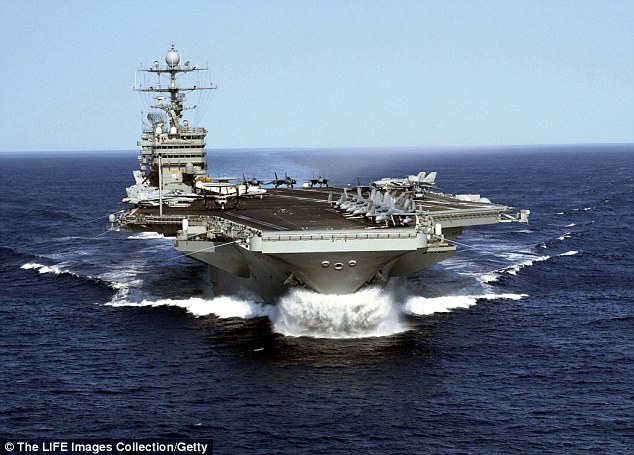
Threatened: Aircraft carriers like the Harry S Truman (pictured) are the backbone of the US Navy, but other countries like China and Russia, have ways to disable or even annihilate carriers in combat, a report says
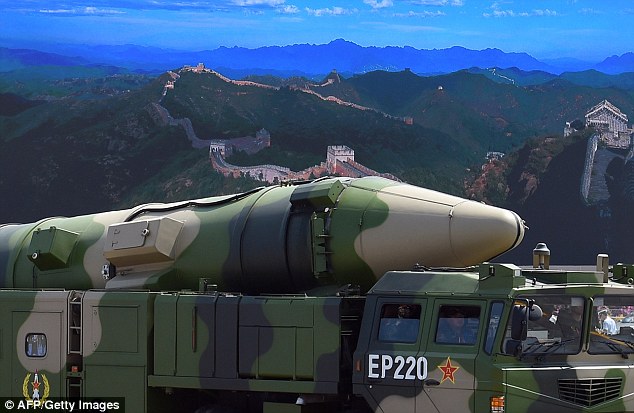
Killer: This DF-21D missile, shown during a parade in Beijing last year, is said to be a 'carrier killer' and would be used as part of the 'area denial' tactics, which block off certain areas to carriers for fear of obliteration

Deployed: China's HQ-9 missile launchers were identified in the report as being an area-denial threat, and were deployed onto a disputed island in the South China Sea this month
The core problem that the US Navy faces, the report says, is that other countries are perfecting 'area denial' methods of blocking off combat areas so that US carriers and their planes can't get close enough to fight effectively without suffering severe damage or even destruction.
They're doing that with newer aircraft, drone technology, submarines and even carrier-busting super missiles that have been developed in recent years. Last month, Iran showed off secret drone footage of the 18-year-old US carrier Harry S Truman.
The newest US carrier currently in active service is the nine-year-old George HW Bush. The oldest is the Nimitz, which took to the sea in 1975.
The US is currently constructing two more carriers, the Gerald R Ford and the John F Kennedy, which will be launched this year and in 2020, respectively. A third, the Enterprise, is scheduled for 2025.
But, says the report, the danger is more immediate. China is 'the pacing threat' right now, with two carrier-busting missiles - the DF-21D and DF-26 - that 'represent a significant threat to the carrier,' being able to take down ships and even reach Guam, a US territory about 2,000 miles away from the Chinese coast.
And Beijing showed willingness to set out areas of strong control around its borders with weaponized artificial islands last year, while placing HQ-9 anti-aircraft missiles - a type specifically identified in the report - on the disputed Woody Island in the South China Sea earlier this month.
That's especially dangerous to US carriers right now because current tactics see them sailing closer to battles than they used to, so that they can send out multiple short-term air attacks rather than relying on their long-distance weapons.
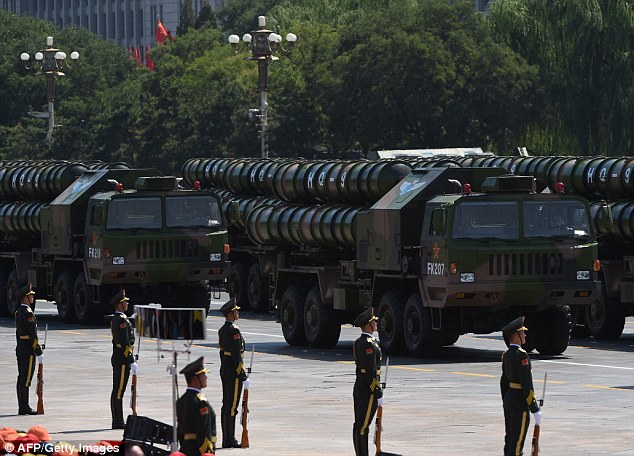
Parade: This military parade, held by Beijing in commemoration of WWII, was a show of Chinese military might, with many missile launchers on display
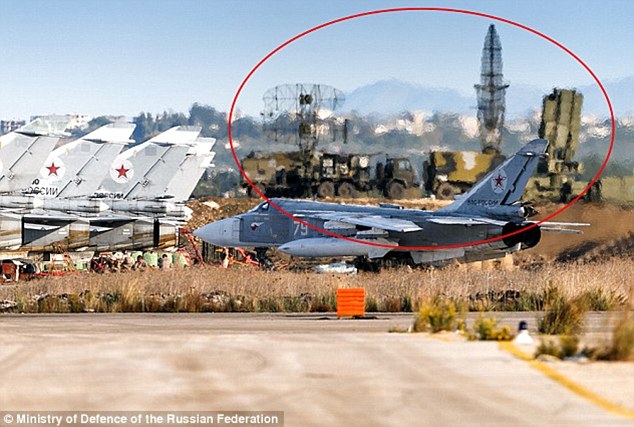
Growler: Russia deployed its SA-21 'Growler' anti-aircraft missiles to Syria last year, giving them coverage over the entire country and much of the eastern Mediterranean. Such weapons are essential for area denial
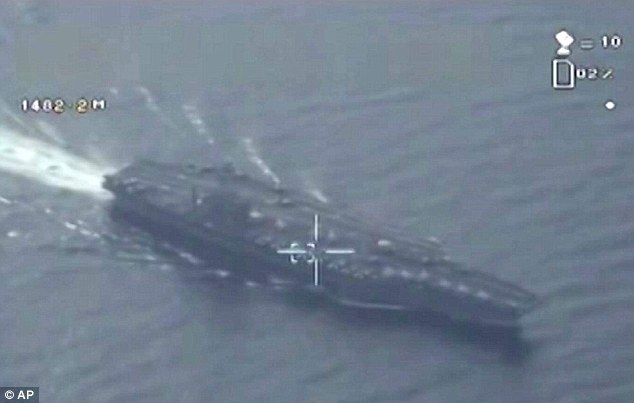
Drone: The USS Harry S Truman was secretly filmed by an Iranian drone last month, with footage being broadcast on Iranian television
The new weapons owned by China and other countries, could be used along with submarines, drones and other armaments designed to restrict the movement of carriers and 'launch a saturation attack against the carrier from a variety of platforms and directions. Such an attack would be difficult - if not impossible - to defend against.'
Russia is also named as a threat in the report, which points out that it made much of the technology used by China, as is Iran. All three countries are noted to be building up arms that can 'place constraints' on US carrier operation.
In November last year, Russia deployed its high-tech SA-21 'Growler' anti-aircraft missiles to Syria, allowing them to target planes over the country and much of the eastern Mediterranean - exactly the kind of weapon that could be combined into an area-denial attack.Solutions given by the report include increasing the distance at which aircraft on the carrier can travel before fighting, shifting money away from carriers and towards submarines and other underwater vehicles, and focusing on future tech like the US Navy's railgun, which can fire shells at seven times speed of sound.
Regardless, says the report, the US needs to quit its obsession with carriers 'and explore innovative options for future operations and force structure.
'If the United States is to maintain its military superiority well into the future, it cannot afford to do otherwise.'
The Center for a New American Security says the US relies on old tactics
- Those tactics make heavy use of aircraft carriers, which can be taken down with a combo of new weapons, tech and tactics deigned to trap carriers
- These 'area denial' systems force carriers to choose between fighting at a distance, where they are less effective, or closing in and risking attack
- 'Such an attack would be difficult - if not impossible - to defend against,' report warns
- China is 'the pacing threat' because of its technological developments
Published: 11:42 EST, 23 February 2016 | Updated: 19:25 EST, 23 February 2016
An obsession with aircraft carriers may end the the United States' naval dominance if military leaders don't change their ways, a report warned today. It says China, Russia and other countries have 'increasingly lethal and precise' weapons and tactics that can destroy carriers, breaking the backbone of the Navy.
Aircraft carriers are at the core of the Navy's arsenal. Not only are the fearsome juggernauts incredibly powerful and difficult to take down, there are also many of them: ten in active service. That's the exact same number of active carriers that every other country in the world has, combined.
But reliance on the behemoths has made the navy complacent, and in serious danger of being taken down by new weapons and tactics displayed by other countries, according to Red Alert: The Growing Threat to U.S. Aircraft Carriers, a report released by bipartisan think-tank Center for a New American Security.

Threatened: Aircraft carriers like the Harry S Truman (pictured) are the backbone of the US Navy, but other countries like China and Russia, have ways to disable or even annihilate carriers in combat, a report says

Killer: This DF-21D missile, shown during a parade in Beijing last year, is said to be a 'carrier killer' and would be used as part of the 'area denial' tactics, which block off certain areas to carriers for fear of obliteration

Deployed: China's HQ-9 missile launchers were identified in the report as being an area-denial threat, and were deployed onto a disputed island in the South China Sea this month
The core problem that the US Navy faces, the report says, is that other countries are perfecting 'area denial' methods of blocking off combat areas so that US carriers and their planes can't get close enough to fight effectively without suffering severe damage or even destruction.
They're doing that with newer aircraft, drone technology, submarines and even carrier-busting super missiles that have been developed in recent years. Last month, Iran showed off secret drone footage of the 18-year-old US carrier Harry S Truman.
The newest US carrier currently in active service is the nine-year-old George HW Bush. The oldest is the Nimitz, which took to the sea in 1975.
The US is currently constructing two more carriers, the Gerald R Ford and the John F Kennedy, which will be launched this year and in 2020, respectively. A third, the Enterprise, is scheduled for 2025.
But, says the report, the danger is more immediate. China is 'the pacing threat' right now, with two carrier-busting missiles - the DF-21D and DF-26 - that 'represent a significant threat to the carrier,' being able to take down ships and even reach Guam, a US territory about 2,000 miles away from the Chinese coast.
And Beijing showed willingness to set out areas of strong control around its borders with weaponized artificial islands last year, while placing HQ-9 anti-aircraft missiles - a type specifically identified in the report - on the disputed Woody Island in the South China Sea earlier this month.
That's especially dangerous to US carriers right now because current tactics see them sailing closer to battles than they used to, so that they can send out multiple short-term air attacks rather than relying on their long-distance weapons.

Parade: This military parade, held by Beijing in commemoration of WWII, was a show of Chinese military might, with many missile launchers on display

Growler: Russia deployed its SA-21 'Growler' anti-aircraft missiles to Syria last year, giving them coverage over the entire country and much of the eastern Mediterranean. Such weapons are essential for area denial

Drone: The USS Harry S Truman was secretly filmed by an Iranian drone last month, with footage being broadcast on Iranian television
The new weapons owned by China and other countries, could be used along with submarines, drones and other armaments designed to restrict the movement of carriers and 'launch a saturation attack against the carrier from a variety of platforms and directions. Such an attack would be difficult - if not impossible - to defend against.'
Russia is also named as a threat in the report, which points out that it made much of the technology used by China, as is Iran. All three countries are noted to be building up arms that can 'place constraints' on US carrier operation.
In November last year, Russia deployed its high-tech SA-21 'Growler' anti-aircraft missiles to Syria, allowing them to target planes over the country and much of the eastern Mediterranean - exactly the kind of weapon that could be combined into an area-denial attack.Solutions given by the report include increasing the distance at which aircraft on the carrier can travel before fighting, shifting money away from carriers and towards submarines and other underwater vehicles, and focusing on future tech like the US Navy's railgun, which can fire shells at seven times speed of sound.
Regardless, says the report, the US needs to quit its obsession with carriers 'and explore innovative options for future operations and force structure.
'If the United States is to maintain its military superiority well into the future, it cannot afford to do otherwise.'












